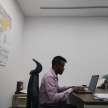Einstein's gravity is combined with quantum mechanics in a new theory.
Today, two papers simultaneously published by UCL physicists reveal a radical theory that consistently unifies quantum mechanics and gravity while maintaining Einstein's classical concept of spacetime.

Today, two papers simultaneously published by physicists at University College London (UCL) announced a radical theory that consistently unifies quantum mechanics and gravity while maintaining Einstein's classical concept of spacetime.
The two pillars of modern physics are Einstein's general theory of relativity, which explains gravity through the bending of spacetime, and quantum theory, which controls the tiniest particles in the universe. However, there is a contradiction between these two theories, and a solution has eluded researchers for more than a century.
It has long been believed that for Einstein's theory of gravity to make sense within the framework of quantum theory, it must be "quantized." This is the methodology of two prominent contenders for a quantum theory of gravity: loop quantum gravity and string theory.
Professor Jonathan Oppenheim of UCL Physics and Astronomy, however, has developed a novel theory that challenges the consensus. It suggests that spacetime might be classical, meaning it might not be governed by quantum theory at all. Professor Oppenheim's theory is presented in a recent paper published in Physical Review X (PRX).
Dubbed a "postquantum theory of classical gravity," the theory alters quantum theory and predicts an intrinsic breakdown in predictability mediated by spacetime, rather than changing spacetime. If an object's apparent weight is measured accurately enough, this leads to larger-than-expected random and violent fluctuations in spacetime, which are not consistent with the predictions of quantum theory.
A second study, led by former Ph.D. students of Professor Oppenheim and concurrently published in Nature Communications, examines some of the implications of the theory and suggests a test experiment that involves precisely measuring a mass to see if its weight appears to change over time.
For instance, a 1 kg mass—which was formerly the 1 kg standard—is regularly weighed by the International Bureau of Weights and Measures in France. The theory can be ruled out if the variations in measurements of this 1 kg mass are less than what is necessary for mathematical consistency.
Leading proponents of quantum loop gravity and string theory, respectively, Professor Oppenheim, Professor Carlo Rovelli, and Dr. Geoff Penington are staking a 5000:1 odds bet on the experiment's result or any other evidence that emerges that would support the quantum vs. classical nature of spacetime.
The UCL research team has been investigating the implications of the theory and putting it to the test for the last five years.
Professor Oppenheim stated: "It's critical to comprehend how the mathematical incompatibilities between quantum theory and Einstein's general theory of relativity are reconciled. Is it better to change quantum theory, quantize spacetime, or do something else entirely? It's anybody's guess now that we have a consistent fundamental theory that avoids quantization of spacetime.
Zach Weller-Davies, co-author, said: "This discovery challenges our understanding of the fundamental nature of gravity but also offers avenues to probe its potential quantum nature." Weller-Davies was a doctoral student at UCL when he developed the experimental proposal and made significant contributions to the theory itself.
We have demonstrated that in the absence of a quantum component, spacetime's curvature must exhibit random fluctuations with an experimentally verifiable signature.
Spacetime must be undergoing violent, random fluctuations on a scale that we haven't yet been able to detect in both quantum gravity and classical gravity. However, for spacetime to be considered classical, the fluctuations must exceed a specific threshold, which can be established through an additional experiment that examines the duration of time that a heavy atom can be in superposition*—that is, in two different places at the same time."
Co-authors Drs. Carlo Sparaciari and Barbara Šoda expressed hope that these experiments could ascertain whether pursuing a quantum theory of gravity is the appropriate course of action. Their analytical and numerical calculations helped steer the project.
Since gravity is manifested through the bending of space and time, Dr. Šoda (formerly of UCL Physics & Astronomy, currently at the Perimeter Institute of Theoretical Physics, Canada) stated: "We can think of the question in terms of whether the rate at which time flows has a quantum nature or classical nature."
"And verifying this is nearly as easy as determining whether a mass's weight is constant or seems to vary in a specific manner."
"The object needs to be weighed with extreme precision, even though the experimental concept is simple," stated Dr. Sparaciari of UCL Physics & Astronomy.
The intriguing part, though, is that we can establish a direct correlation between two measurable quantities—the size of spacetime fluctuations and the length of time that atoms or apples can be placed in a quantum superposition of two distinct locations—starting from very general assumptions. Then, we can conduct experiments to determine these two quantities.
"A delicate interplay must exist if quantum particles, like atoms, are able to bend classical spacetime," Weller-Davies continued. The size of the random fluctuations in spacetime and the wave nature of atoms must be fundamentally balanced.
Another experimental proposal that aims to confirm the quantum nature of spacetime by searching for "gravitationally mediated entanglement" complements the proposal to test whether spacetime is classical by looking for random fluctuations in mass.
While not involved in today's announcement, Professor Sougato Bose of UCL Physics and Astronomy was one of the original proposers of the entanglement experiment. He stated: "Experiments to test the nature of spacetime will take a large-scale effort, but they're of huge importance from the perspective of comprehending the underlying principles of nature. These experiments seem feasible to me; although the results are unpredictable, maybe we'll know in the next 20 years.
Beyond gravity, the postquantum theory has implications. Quantum superpositions inevitably localize through their interaction with classical spacetime, negating the need for the notorious and problematic "measurement postulate" of quantum theory.
Professor Oppenheim's attempt to find a solution to the black hole information problem served as the inspiration for the theory. Since information cannot be destroyed, standard quantum theory states that an object falling into a black hole should radiate back out in some way. However, this defies general relativity, which states that objects that cross a black hole's event horizon can never be known to exist. The updated theory permits data to be lost as a result of a basic breakdown in predictability.






Comments
There are no comments for this story
Be the first to respond and start the conversation.